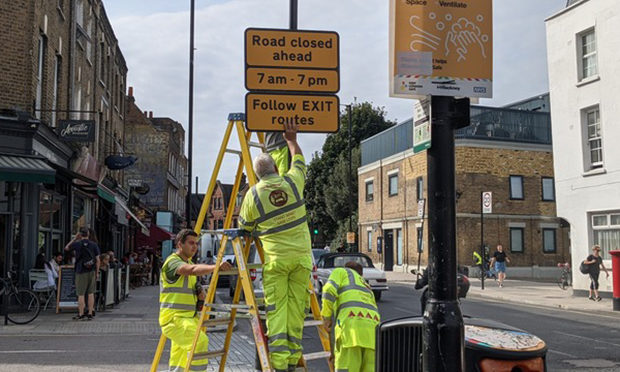Council transport chief grilled on impact of Hackney’s 19 low traffic neighbourhoods

Campaigners have quizzed council bosses about the impact of low traffic neighbourhoods (LTNs) on schools and homes that fall outside the boundaries of the schemes.
Hackney has 19 LTNs, with those in Hackney Downs, Homerton and Hoxton West now in place permanently after a trial period.
The borough also has 40 school streets, which prevent cars using nearby roads at the start and end of the school day.
LTN critic Clair Battaglino said she fears the measures are “displacing traffic from areas with cleaner air onto roads where there are many of Hackney’s most deprived schools”.
Hackney’s transport chief Cllr Mete Coban said: “We have seen very decisive action on what we can to improve air quality.”
He said LTNs are not the only solution to air pollution, and added that “what we do need to see is less people driving through Hackney to get where they need to, and we need to see people driving fewer short trips and taking up public transport, cycling and walking”.
LTNs prevent drivers using roads during peak hours and were brought in to discourage the number of motor vehicles on Hackney’s roads and cut air pollution.
Many of them came in during the pandemic to help with social distancing, but some were already in the pipeline.
According to the council’s latest research, there was an almost even split in favour of keeping or removing the LTNs.
Transport for London has funded similar schemes across London as part of the response to the climate emergency and the pandemic.
Residents brought their concerns to Hackney’s cabinet meeting this week, and more questions will be discussed at full council tomorrow.
Cllr Coban said: “What we want to see is reduced car use in Hackney.”
He said monitoring air quality is crucial, with 300 sites measuring air quality at the LTNs. Each road closure is considered on its merits.
The transport boss added: “One of the key primary aims of the low traffic schemes is that we are improving public health and to reduce overall air pollution and encourage active travel.
“We know that in Hackney we’ve got one of the worst levels of air pollution in London. As a centrally located borough, there are lots of people driving through Hackney to get to where they need to.”
He said there “needs to be that fair balance to make sure our kids don’t grow up with stunted lungs”.
Some pollution levels near school streets have dropped by 74 per cent, he said.
Resident Ruth Parkinson wanted to know when the results of an independent survey of views about LTNs commissioned by the council will be available.
Cllr Coban said traffic was down by 38 per cent inside LTNs and two per cent on main roads and boundary roads.
He revealed that the latest research found that 26 per cent of people quizzed said they were encouraged to walk or run, with 24 per cent saying they were encouraged to cycle.
“It also showed significant support for our aims to build a greener Hackney programme, with 66 per cent of people in support and 72 per cent of people supporting all or some of our school streets to make them permanent,” he added.
He said 79 per cent of people know about LTNs. However, they are split on keeping them, with 48 per cent in favour of retaining all or some, and 47 per cent wanting them removed.
Imogen O’Rorke asked what is being done to mitigate the impacts of pollution from motor vehicles on people “on low incomes, people of minority ethnic backgrounds, the elderly and children”.
Cllr Coban said LTNs are “proven to benefit” vulnerable members of the community, and people on lower incomes are more likely to use public transport, with just a third of residents owning a car.
He said the council will work with residents to make changes to LTNs.
“We want to see reduced car usage so you and your neighbouring residents don’t have to suffer from bad air pollution,” he added.
